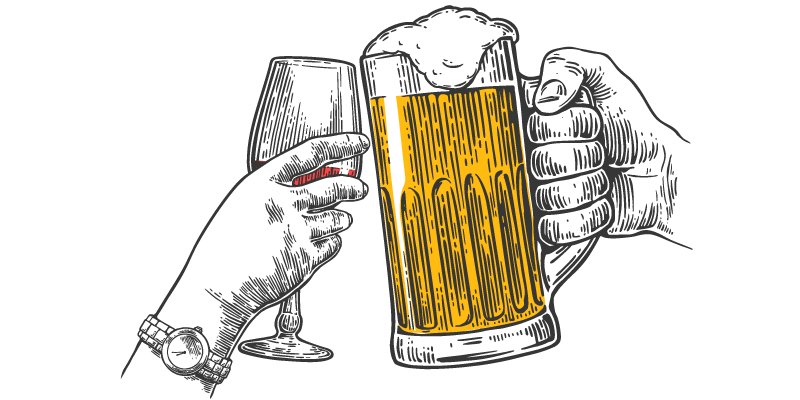Fact: beer lovers who refuse to drink wine are missing out. Yes, of course, beer and wine are two very different beverages. Beer is brewed year-round from a variety of starches, treated more like an ever-evolving recipe to experiment with and perfect. It’s seen as a casual, (usually) unpretentious beverage, created to be delicious and drinkable no matter the circumstance. Wine, on the other hand, is produced only once each year from grapes of different varieties, a lifelong study in coping with nature’s whims while expressing a winery’s style in both the vineyard and the cellar. It can be seen as snobbish, requiring knowledge and contemplation to enjoy, and typically needing a food pairing.
But while these basic facts and generalizations are indeed correct, they are also far too limiting. Beer can be a serious, complex, food-worthy beverage, and wine can be simple, refreshing, and chuggable. The rise of smaller, more artisanal producers has elevated the quality of both beverages, expanding not only the different styles of these drinks but the nuances within each style. And, while wine and beer are made in different ways, from different products, they are both fermented, alcoholic beverages that can truly share flavor and structural similarities, believe it or not.
Still doubtful? Not for long. Here are six popular styles of beer and their wine equivalents, ready to be tested by dubious beer drinkers galore. And while you’re out at the wine shop, you might as well pick up a second fridge as well, because your beverage collection is about to double in size.
If you drink lagers/pilsners, try… Verdejo from Rueda
Two of the most misconceived styles of beer may just be the lager and the pilsner. Thanks to big brands that rhyme with “Mud Fight,” lagers and pilsners are often thought of as uninteresting and forgettable, suitable for sipping mindlessly at barbecues. Mass production has taken away the essence of what lagers and pilsners are, though: crisp, refreshing, and sometimes quite yeasty and savory.
Verdejo from Spain’s Rueda region showcases all of the qualities that beer drinkers crave when they reach for a lager or a pilsner. While at first sip Verdejo seems like a simple, acid-driven white, these wines should be prized for their clean drinkability and bright citrus flavors, sometimes so peppy that they seem slightly effervescent. A slight almond skin note is also typical in Verdejo, mirroring that hidden savory quality of good lagers and pilsners.
Another option for lager and pilsner drinkers is the always-reliable Pinot Grigio, a beverage just as misunderstood as these two beer styles. Look for versions from Friuli and Alto Adige to overthrow perceptions that Pinot Grigio is boring and tasteless; these examples will have fresh apple fruit and citrus and a certain “beer foam” reminiscent quality that will make beer lovers feel right at home.
If you drink wheat beers/hefeweizens, try… Albariño from Rías Baixas
Somehow, wheat beer has become the most polarizing style of beer in America, which is odd for a country that has embraced super-bitter double IPAs and uber-funky-salty goses so readily. Offer some lager lovers a wheat beer in substitution for their preferred bottle and they’ll respond with an adamant “no.” Offer hefeweizen to IPA aficionados? They might just laugh in your face. It may be because these thirst-quenching beers are intensely fruity, from the orange and coriander flavors of Belgian-style witbier to the banana and close flavors of a traditional hefeweizen.
This aromatic, fruit-driven but not overly sweet style of beer is echoed in the Albariños of Rías Baixas in northwestern Spain. Like wheat beer, Albariño is intensely fruity on the nose, with aromas of tropical fruit, ripe peach, and meyer lemon, but incredibly fresh on the palate, with zippy lime flavors, salinity, and tons of texture. In almost complete contrast to the aromas, the acidity removes any illusion of sweetness, leaving the mouth refreshed and ready for another sip. And for those who’ve wrinkled their noses at wheat beers up until now? No Albariño for you! (Just kidding … sort of.)
If you drink pale ales, try… Grüner Veltliner
Those who tend toward pale ales like to taste hops in their beer, but they don’t want them to dominate the flavor profile. Rather than smacking the drinker in the face, hops in pale ales contribute a fresh greenness to the beer, grassy or floral and slightly bitter, but complemented by bright citrus as well.
This is best exemplified in Austria’s Grüner Veltliner wines, which have a characteristic, mild green quality. Think arugula and chive along with a slightly bitter and spicy quality, like white pepper and radish, all pulled together with tart lime and grapefruit citrus. The amount of bright acidity in Grüner Veltliner also lends itself to seeming a bit mouth puckering, along with tons of rocky minerality.
If you drink IPAs, try… Sancerre
While IPAs (and double IPAs) technically reside within the pale ale category, most American or British pale ales are noticeably less hoppy than IPAs. If pale ales use hops as seasoning, IPAs feature hops as the lead ingredient, making their strong, bitter greenness known immediately. There’s no mistaking an IPA in the glass; those hops, while they can fall along the spectrum from citrus to floral to spice, pop out of the glass.
There is a compound found in certain grape varieties that contributes an unmistakable green quality to these wines: pyrazines. Sauvignon Blanc is the one white grape that has a high proportion of pyrazines, and it mimics this fresh, intense hop quality in the citrus-driven wines of Sancerre. Rather than the super-vegetal, green bell pepper flavors of New Zealand Sauvignon Blanc, Sancerre’s green quality tends to present as just-cut grass or fresh herbs like basil and parsley. Acid-driven, grapefruit and lemon citrus make Sancerre refreshing and slightly bitter, satisfying even the biggest hopheads.
IPA drinkers are nothing if not adventurous, so some may find themselves wanting to explore the world of red wines as well. Pyrazines are present in most wines made from Bordeaux-family grapes, but that intense green quality will stand out most in Cabernet Franc from the Loire Valley and Carménère or Cabernet Sauvignon from Chile.
If you drink goses/sour beers, try… Loire Valley whites
The popularity of the sour beer style has soared in the past several years, with the prominence of gose, a specific style of sour wheat beer brewed with coriander and salt, exploding in the past year or two. Sour beers and goses vary in style but tend to be tart, funky, earthy, and notably high in acidity; in other words, these are inherently very wine-like beers. So, good news, sour beer drinkers: there are tons of high-acid, savory, funky white wines that you’ll love!
The Loire Valley is a mecca for both small, natural wine producers and mineral-driven, savory white wines. Lovers of salty, tart, but less funky goses should look to the Loire region of Muscadet near the ocean, where white wines made from Melon de Bourgogne have ripping acidity and minerally, lemon citrus flavors. For funky sour beer lovers, move inland, where Chenin Blanc can develop flavors of bruised yellow apple, parmesan cheese rind, wool, toasted nuts, and more, particularly from producers of natural wine who allow brettanomyces to affect their wines. Other great options include the wines of the Jura, Etna Biancos from Sicily, and even Slovenia’s skin-contact whites.
If you drink stouts/porters, try… Merlot
Drinkers of stouts and porters crave the comforting richness of these beers’ roasted, malty flavors, often giving off notes of chocolate, coffee, and toffee. These beers, with exceptions, also tend to be less bitter and heavier, without being cloying. Red wine is the way to go here, specifically the Merlot/Malbec/Shiraz triangle. All these wines, which can often be mistaken for one another, are going to have the soft richness of fruit, yet balanced acidity that lovers of stouts and porters look for.
Among these three grapes, however, Merlot is the winner. California Merlot, when made well – so, not Two Buck Chuck – tends to have lush black cherry and blackberry fruits, baking spice, bittersweet chocolate, mocha, and coffee. Merlot from cooler parts of Napa and Sonoma is even better, as the lower temperatures help preserve acidity and fresh flavors, rather than jammy ones.

